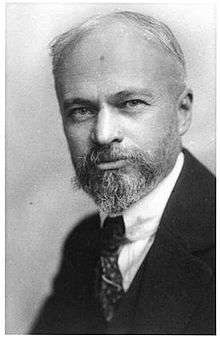Harrison Gray Dyar Jr.
Harrison Gray Dyar Jr. (February 14, 1866 in New York City – January 21, 1929 in Washington, D.C.) was an American entomologist.
Harrison Gray Dyar Jr. | |
|---|---|
 | |
| Born | February 14, 1866 New York City, U.S. |
| Died | January 21, 1929 (aged 62) Washington, D.C., U.S. |
| Nationality | American |
| Citizenship | United States |
| Alma mater | Massachusetts Institute of Technology (B.S.) Columbia University (M.A.) Columbia University (Ph.D.) |
| Years active | 1889–1929 |
| Known for | Scientist, entomologist |
| Parent(s) | Harrison Gray Dyar, Eleonora Rosella Hunt |
| Relatives | Harrison Gray Otis (second cousin) |
Early life
He was a son of Harrison Gray Dyar and his wife Eleonora Rosella (née Hannum).[1][2] Dyar graduated from Massachusetts Institute of Technology in 1889 with a Bachelor of Science degree in chemistry. He had begun to study insects as a young teenager,[1][3] and soon after his graduation from college began publishing scientific papers about them, in particular moths of the family Limacodidae,[1] starting a lifelong interest in entomology. He was awarded a Master of Arts degree in biology from Columbia University in 1894, with his thesis on the classification of Lepidoptera, and a Doctor of Philosophy degree in 1895, with his dissertation on airborne bacteria in New York City.[1][4]
Taxonomy
Dyar was a taxonomist who published extensively on moths and butterflies (Lepidoptera), mosquitoes (Diptera: Culicidae), and sawflies (Hymenoptera: Symphyta) during his working lifetime.[4] His first job was as assistant bacteriologist of the College of Physicians and Surgeons of Columbia University from 1895 to 1897.[4] From 1897 until his death he was honorary custodian of Lepidoptera at the U.S. National Museum, Washington, D.C.[4] Dyar was independently wealthy and for a major part of his 31 years at the USNM he worked without compensation; his independence also made it possible for him to travel and collect extensively within North America.[4]
Dyar's Law, a biological rule named for him in recognition of his original observations on the geometric progression in head capsule widths during the larval development of Lepidoptera, is a standard tool for studying immature insects.[1] An earlier publication in 1886 by W.K. Brooks independently described the same phenomenon in crustaceans,[5][6] and therefore the variant term "Brooks-Dyar Law" (or "Brooks Rule" or "Brooks-Dyar Rule") also commonly appears in the literature.[7]
Dyar was editor of the Journal of the New York Entomological Society from 1904 to 1907 and of the Proceedings of the Entomological Society of Washington from 1909 to 1912; from 1913 to 1926 he published and edited his own taxonomic journal, Insecutor Inscitiae Menstruus.[4] Dyar and Frederick Knab were primarily responsible for the taxonomic portions of The Mosquitoes of North and Central America and the West Indies, published, with co-author L. O. Howard, in four volumes from 1912–1917.[4]
Dyar was also noted for his intellectual and at times acerbic exchanges with fellow entomologists, for example, in correspondence with Clara Southmayd Ludlow,[8] he engaged in a "protracted, spectacularly belligerent feud with fellow entomologists".[9]
In 1924, Dyar was commissioned a captain in the Sanitary Department of the U.S. Army Reserve Officers Corps because of his background in the study of mosquitoes.[10]
Personal
Dyar was a bigamist, "for fourteen years he was married to two women, maintaining two families with five children in all."[1][9] He married Zella M. Peabody of Los Angeles, a music teacher in 1889. They had two children.[1] This marriage ended in 1920.[9] But in 1906, using the alias of Wilfred P. Allen, Dyar married Wellesca Pollock.[9] In 1921, now divorced from Peabody, Dyar legally married Pollock; they had three sons.[1]
Pollock was an educator and ardent disciple of the Baháʼí Faith.[1] After his legal marriage to Pollock, Dyar became active in the Baháʼí Faith, and edited an independent Baháʼí journal, Reality, from 1922 until his death.[1]
During the 1920s, Dyar's hobby of tunnel building was discovered when a truck broke through into a labyrinth of tunnels near his former home in Washington, D.C.[1][2][9]
Dyar was a second cousin of American Civil War soldier and publisher Harrison Gray Otis.[11]
References
- Pamela M. Henson: Dyar, Harrison Gray Jr., Baháʼí Library Online, http://bahai-library.com/henson_harrison_dyar. Retrieved Nov 5, 2010.
- Marc E. Epstein and Pamela M. Henson. 1992. Digging for Dyar, The Man Behind the Myth. American Entomologist 38:148–169.
- Frank E. Dyer: Dyer Families of New England, Descendants of Thomas Dyer of Weymouth, Mass, http://freepages.genealogy.rootsweb.ancestry.com/~dyer/. Retrieved Nov 5, 2010.
- Kenneth L. Knight & Ruth B. Pugh. 1974. A Bibliography of Mosquito Writings of H. G. Dyar and Frederick Knab. Mosquito Systematics 6(1): 11–26.
- Brooks WK 1886. Report on the Stomatopoda collected by H.M.S. Challenger during the years 1873–76. In: The voyage of H.M.S. Challenger, report 45, vol.16
- Crosby, T.K. 1973 Dyar's rule predated by Brooks' rule. New Zealand Entomologist: 5 (2):175-176
- Daly, H.V. 1985 Insect morphometrics. Annual Review of Entomology 30: 415-438
- Ronald R. Ward. 1987. Biography of Clara Southmayd Ludlow 1852–1924. Mosquito Systematics 19(3): 251–258, edited reprinting of information first published by James B. Kitzmiller: Anopheline Names, Their Derivations and Histories, The Thomas Say Foundation, Vol. VIII, 1982, pp. 316–321.
- Foster, William (January 14, 2016). Campbell, Philip (ed.). "A life of insects and ire". Nature. London: Macmillan Publishers Ltd. 529 (7585): 152–3. doi:10.1038/529152a. ISSN 0028-0836.
- Terry L. Carpenter and Terry A. Klein. 2011. 2011 AMCA Memorial Lecture Honoree: Dr. Harrison Gray Dyar Jr. Journal of the American Mosquito Control Association 27(3):336–343.
- Harrison Gray Dyar Jr.: A Preliminary Genealogy of the Dyar Family, Gibson Bros., Printers, Washington, D.C., 1903, p. 16.
Further reading
- Epstein, Marc (2016). Moths, Myths, and Mosquitoes: The Eccentric Life of Harrison Dyar Jr. Oxford University Press. ISBN 9780190215279.
External links
- "Tunnel Digging as a Hobby" Modern Mechanix (1932) featuring a diagram of one of Dyar's tunnels
- The Bizarre Tale of the Tunnels, Trysts and Taxa of a Smithsonian Entomologist